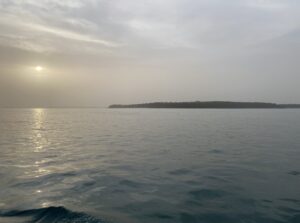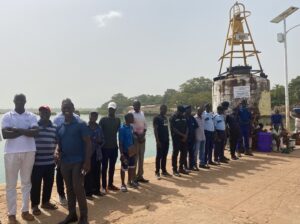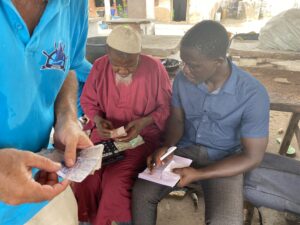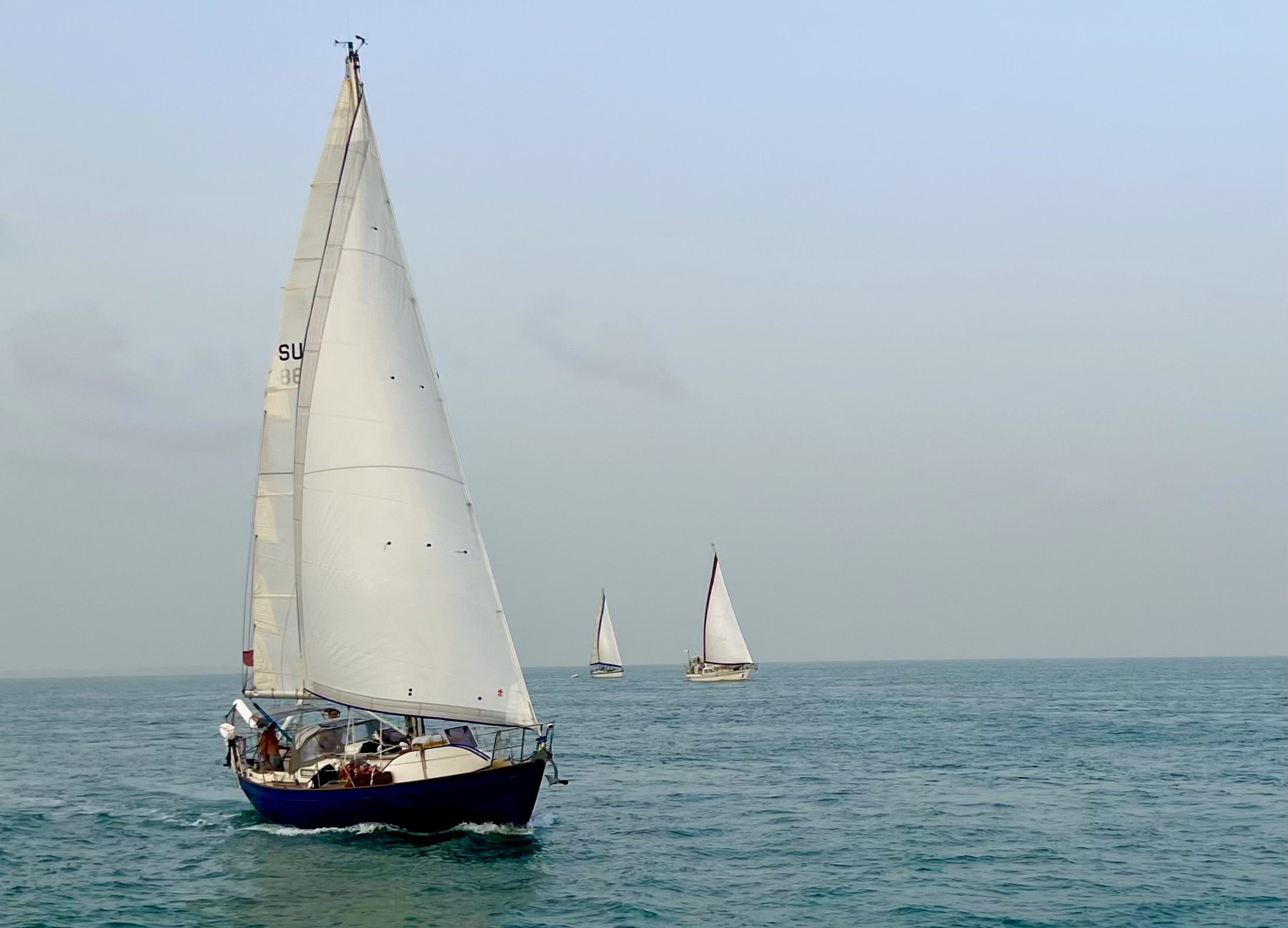As the sun rose from behind the haze 7 November 2023, it revealed our anchorage, which we had approached in complete darkness the night before. Perhaps half a nautical mile away lay a flat island. It almost seemed to float on the brownish water and not be real. It seemed like something out of a dream. Its green core of jungle rose above a fringe of light-coloured sand. Bird calls drifted across the water. But there were no people to be seen anywhere.
Orangosinho, as this piece of land in the middle of nowhere is called, was our first encounter with the Bijagós archipelago. This consists of 88 islands and islets. But there was no sign of the neighbouring islets that morning. As if Orangosinho was the only solid ground far and wide.

The island of Orangosinho in the haze.
The seven other yachts on our expedition were a little closer to the shore. We had dropped anchor in five metres of water and thought we were much closer to land. But the waters through which the Bijagós flow are not deep. In the large canals, it can sometimes be over 30 metres. But the side branches of this huge network of waterways are only navigable for yachts like ours at high tide, if at all.
And the tides play a major role in this world far from the beaten track of yacht tourism. The difference between high and low water can be up to four metres, and the tides are accompanied by a current that sometimes turns the channels into raging rivers. They reach over two knots, if not more, and pump the water from the archipelago into the sea and back again. However, they also carry a lot of rubbish. Slippers and shoes, bottles, canisters, plastic bags and sachets, shredded fishing nets, cleaning sponges, ladies‘ bags, frayed lines. Everything that so-called civilisation produces in plastic floats past us this morning.
And that’s exactly why we’re here. Actually.
It all began in the Azores
The story of this journey actually begins much earlier. Sometime shortly after my return from the Canary Islands in spring 2023. On the terrace of the Clube Nautico in Vila do Porto on my home island of Santa Maria in the Azores, I meet a gaunt man with thinning hair and a three-day beard. His name is Miguel Teixeira. His family comes from Madeira and it is said that he is a descendant of the Tristão Vaz Teixeira who, in 1419, was part of the group of Portuguese who set foot for the first time on Madeira.
Miguel is an entrepreneur and perhaps also a kind of adventurer like his ancestor. Today, however, I’m not sure whether I should see him as a clever businessman or a romantic dreamer. But perhaps these qualities are not mutually exclusive.
On the terrace of the Clube Nautico overlooking the harbour, Miguel tells me about the Bijagós, which I had never heard of before. He describes them as a paradise, perhaps the last paradise in Africa, whose people still live according to old traditions, where queens rule and rituals determine their existence. But this paradise is in danger of being swallowed up by rubbish, says Miguel. And that’s why we should sail there: To collect plastic, determine its origin and write a report. All in the hope of raising funds to tackle the problem.
I was immediately enthusiastic about the project because it combined sailing with a purpose. It made travelling meaningful and would also take me to an area I would never travel to on my own: Africa was not only terra incognita for me. I was also afraid of corruption and the possibility of losing the boat there if it was damaged in any way.
But Miguel not only promised to organise the trip, obtain visas and helpers on site. The voyage was also to be organised under the auspices of the Portuguese embassy. That sounded good and safe. I agreed.
Pijamas and baby clothes on board
Before we set off, however, the purpose of the enterprise had already changed a little. Our expedition, which had initially been labelled scientific, became a scientific-humanitarian one and three large bags of clothes arrived on board Blue Alligator: Pijamas and baby stuff from the local charity collection.
Miguel had also organised hospital supplies and food to distribute on the island. When we set off from Cape Verde for the final leg to the Bijagós, the eight yachts were like floating second-hand warehouses. And now we had arrived with our cargo, the distribution of which only Miguel knew about. In any case, nothing would be unloaded on Orangosinho. Instead, we had to weigh anchor in the morning.
The next destination was Bolama. The town lies around 40 nautical miles to the north in a side arm of the main fairway. We wouldn’t reach it on the same day because the tide capsized beforehand. So we agreed on another anchorage. This was much closer to the shore between two islands, the larger Roxa and the much smaller Ilheus dos Porcos. We didn’t see any pigs. But this anchorage really deserves to be described as paradisiacal, especially as it was largely free of rubbish streams.

Goats on the square in Bolama.
Even though the channels are sometimes relatively narrow, we tried to sail whenever possible. And aided by the tidal current, we reached Bolama in good time the following day.

The line-up for our reception in Bolama.
We were finally expected. The town’s officials had lined up on the long pier that juts out into the water: police officers from all sorts of units, representatives of the governor of the Bijagos, people responsible for fishing and probably someone in charge of tourism. We shook dozens of hands, mentioned our names just as often and got the feeling that we were the representatives of a really important delegation, although in our uniform T-shirts, which Miguel had had made, we looked more like an ageing scout troop.
Colonial splendour in ruins – Bolama
From 1879 until 1941, Bolama was the capital of the Portuguese colony of Guinea-Bissau until it gained its independence in 1974 – in a bloody war. The city’s colonial past is clear to see. But what were once palatial buildings, a public bath, bars and cafés are now largely ruins. The colonial splendour has crumbled and people sometimes live in hollowed-out remnants of their former masters, with no thought of rebuilding. The market in the centre has hardly anything to offer. At least we can exchange money with a trader there. It’s like a beehive as the thousands of African francs change hands for euros. The two cats sleeping under the trader’s bench are not disturbed by this.

Changing Money in the market for Bolama.
In Bolama we get our visas and entry stamps, which costs us over 80 euros each. Travelling in Africa is not cheap. At first, the authorities also want to keep our passports. We successfully defend ourselves against this. But the procedures take time and the first day in Bolama comes to an end without us having achieved or seen much. The only thing we managed to get hold of was an excellent lunch. Whether the place where we ate was a restaurant or just a private home is impossible to say. In any case, the grilled fish with rice and a spicy sauce was delicious.
The uncrowned king of the Bijagós
Waiting will become a habit in the coming days. But now we had made our way into the heart of the Bijagós and were soon to meet a man who, for me, epitomises something like the uncrowned king of the Bijagós, a man with a dream and the will to realise it: Adelino Da Costas. I will introduce him in the next blog post.

Pingback: Vorstoss ins Herz der Bijagós – Meergeschichten
Wir verfolgen die Abenteuer in Meergeschichten mit grossem Interesse, vorallem seit Cayetano vom Nomada ein Stück mit von der Partie war. Er hat mir sofort vom Schweizer mit dem Boot unter 🇨🇭 Flagge erzählt!
Wir wünschen weiterhin gute Winde und hoffen auf spannende Erzählungen.
Cornelia y Cayetano
Das freut mich sehr. Danke euch. Und herzliche Grüsse, Ronald
Pingback: The king of the Bijagós – Meergeschichten
Pingback: Tourism instead of plastic - Meergeschichten
Pingback: Sailing through narrow waters in the Bijagós - Meergeschichten